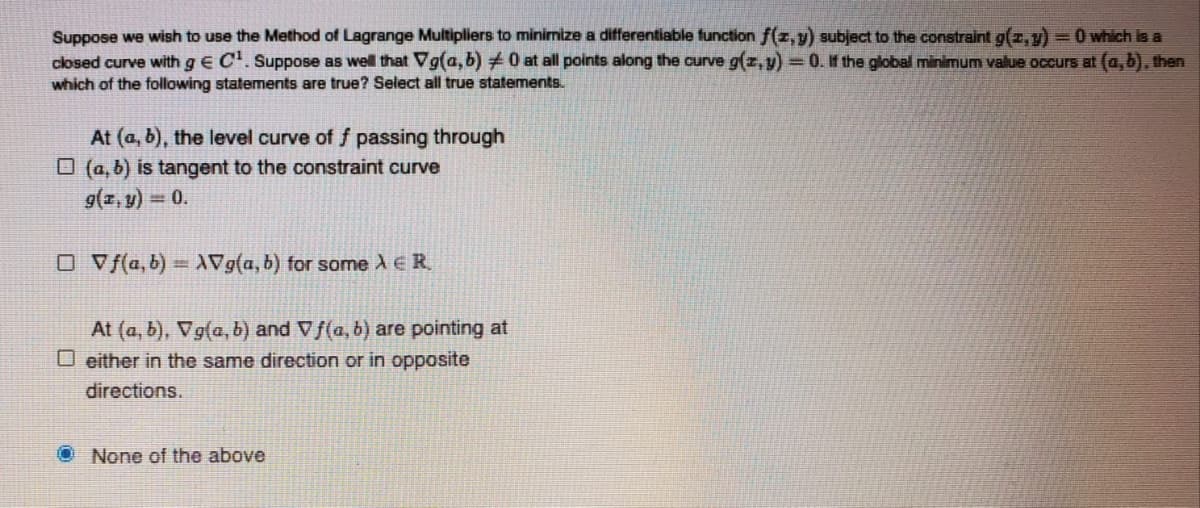Suppose we wish to use the Method of Lagrange Multipliers to minimize a differentiable function f(z, y) subject to the constraint g(z,y) = 0 which is a closed curve with g € C'. Suppose as well that Vg(a, b) +0 at all points along the curve g(z, y) =0. If the global minimum value occurs at (a, b), then which of the following statements are true? Select all true statements. At (a, b), the level curve of f passing through O (a, 6) is tangent to the constraint curve g(z, y) 0. O Vf(a, b) = Vg(a, b) for some Ae R At (a, b), Vg(a, b) and Vf(a, b) are pointing at O either in the same direction or in opposite directions. None of the above
Suppose we wish to use the Method of Lagrange Multipliers to minimize a differentiable function f(z, y) subject to the constraint g(z,y) = 0 which is a closed curve with g € C'. Suppose as well that Vg(a, b) +0 at all points along the curve g(z, y) =0. If the global minimum value occurs at (a, b), then which of the following statements are true? Select all true statements. At (a, b), the level curve of f passing through O (a, 6) is tangent to the constraint curve g(z, y) 0. O Vf(a, b) = Vg(a, b) for some Ae R At (a, b), Vg(a, b) and Vf(a, b) are pointing at O either in the same direction or in opposite directions. None of the above
Algebra & Trigonometry with Analytic Geometry
13th Edition
ISBN:9781133382119
Author:Swokowski
Publisher:Swokowski
Chapter9: Systems Of Equations And Inequalities
Section: Chapter Questions
Problem 12T
Related questions
Question
Please select correct option

Transcribed Image Text:Suppose we wish to use the Method of Lagrange Multipliers to minimize a differentiable function f(z,y) subject to the constraint g(z,y) = 0 which is a
closed curve with g € C'. Suppose as well that Vg(a, b) +0 at all points along the curve g(z, y) =0. If the global minimum value occurs at (a, b), then
which of the following statements are true? Select all true statements.
At (a, b), the level curve of f passing through
O (a, b) is tangent to the constraint curve
g(z, y) = 0.
O V/(a, b) = AVg(a, b) for some A E R.
At (a, b), Vg(a, b) and Vf(a, b) are pointing at
O either in the same direction or in opposite
directions.
O None of the above
Expert Solution
This question has been solved!
Explore an expertly crafted, step-by-step solution for a thorough understanding of key concepts.
Step by step
Solved in 2 steps with 5 images

Recommended textbooks for you

Algebra & Trigonometry with Analytic Geometry
Algebra
ISBN:
9781133382119
Author:
Swokowski
Publisher:
Cengage

Algebra & Trigonometry with Analytic Geometry
Algebra
ISBN:
9781133382119
Author:
Swokowski
Publisher:
Cengage